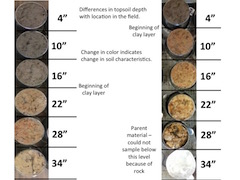December 16, 2016
Gretchen Sassenrath develops soil health research program in southeast Kansas

Gretchen Sassenrath, associate professor of agronomy, is developing a soil health research program in southeast Kansas in an effort to better understand the mechanisms contributing to soil erosion and the extent of erosion in crop production fields.
The Middle Neosho Watershed encompasses portions of five predominantly agricultural counties in southeast Kansas and ends where the Neosho River crosses the state line into Oklahoma. Agricultural activities together with high rainfall rates contribute to loss of sediments and nutrients from the erosion-prone silt loam soils. Erosion has impaired the water quality of streams and rivers in the Middle Neosho Watershed as well as downstream water resources in neighboring states. These transboundary negative environmental impacts introduce critical environmental conflicts in the region and are similar to problems occurring in other locations in the U.S. and the world.
Sassenrath's research team hypothesizes that underlying soil characteristics, such as the claypan layer, may exacerbate soil loss. A University Small Research Grant from the K-State Office of Research and Sponsored Programs in fall 2015 helped Sassenrath analyze terrain, sample soil and test and map soil electrical conductivity. Relating soil electrical conductivity to physical properties of soils demonstrates the extent of soil variability within the field, changes in soil textural characteristics with depth in the soil, such as clay content and the depth of the productive silt-loam topsoil layer.
"To date, we have found the depth to claypan varies greatly across a field. Moreover, the extent of topsoil loss is not consistent with topographic position, so other factors appear to play a greater role in sediment and nutrient loss," Sassenrath said.
"Understanding the fundamental processes of erosion in these claypan soils allows us to develop better management practices to reduce sediment and nutrient loading to streams and waterways," she said.
Sassenrath presented her research results at three recent conferences. She presented "Healthy water: The role of soil health in securing water resources" at the Governor's Conference on the Future of Water in Kansas in November; "In-field variability of terrain and soils in southeast Kansas: Challenges for crop production" at the American Society of Agronomy Annual Meeting, also in November; and "In-field variability of terrain and soils in southeast Kansas: Challenges for effective conservation" at the 71st International Annual Conference of the Soil and Water Conservation Society in July. She also regularly communicates with southeast Kansas producers through the Southeast Agricultural Research Center.
Sassenrath has submitted a proposal to the National Science Foundation to continue funding her work. She has two manuscripts and several extension publications in development.
Sassenrath's project also was supported by the K-State Research and Extension Southeast Agricultural Research Center.
